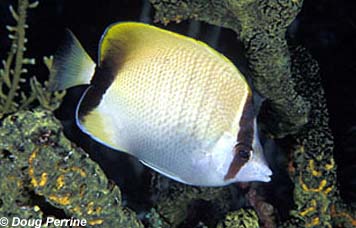
Chaetodon sedentarius
This is the more rectangular shaped of the butterfly fish that inhabit the Western Atlantic. It has a black bar down its face and another down the posterior of its body and fins, with yellow on its fins and a yellow tail. Like other butterfly fish, it lives around the coral reefs, and is ideally shaped to poke into crevasses for invertebrates to eat. Butterflyfish show pair fidelity and are territorial, so although they are popular for aquariums, they can be difficult to maintain.
Order – Perciformes
Family – Chaetodontidae
Genus – Chaetodon
Species – sedentarius
Common Names
English language common names are reef butterflyfish, butterbun, least butterflyfish, school mistress, and katy. Other names include chamba hel (Papiamento), kuroobi-chochouo (Japanese), mariposa (Spanish), and parche mariposa (Spanish).
Importance to Humans
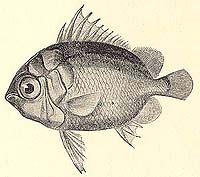
The flesh of the reef butterflyfish is not toxic, but they are generally not harvested for food. They are, however, taken for the aquarium trade. Their diet may make them somewhat of a problem to maintain, though the juveniles seem to thrive better in captivity than the adults.
Conservation
> Check the status of the reef butterflyfish at the IUCN website.
The IUCN is a global union of states, governmental agencies, and non-governmental organizations in a partnership that assesses the conservation status of species.
Geographical Distribution

It is a tropical western Atlantic species, found in the waters of the Carolinas to northern South America, including the Gulf of Mexico and the Caribbean Sea.
Habitat
The reef butterfly, as its name suggests, is primarily a reef species. The reef provides plenty of hiding spaces for these fishes as well as good habitat for the small invertebrates on which it feeds. Its depth distribution coincides with the limits of coral growth; it can live in the shallows and as deep as the light restricts coral growth. Generally it inhabits deeper parts of the reef 48-130 feet (15-40 meters) than other species of butterflyfish in the area.
Biology
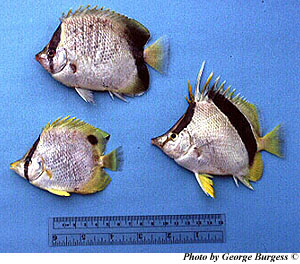
Distinctive Features
The reef butterflyfish, Cheatodon sedentarius, gets its name from its flitting movements about the reef and its beautiful color pattern that resembles the movements and appearance of the insect. The reef butterfly is a highly compressed species, designed for maneuverability and short bursts of speed, not for endurance swimming. This body plan is ideal for maneuvering about the coral reef. It has a short, pointed snout, and a long dorsal fin that separates in the beginning into spines.
Coloration
The reef butterflyfish has a silver body, yellow and black dorsal fin, and yellow tail. There are two distinguishing vertical black bars on the body. One is on the head and runs down through the eye. The other one runs down along the rear of the body, including the rear portion of the dorsal and anal fins. Juvenile reef butterflyfish differ in coloration as the dark posterior area may be faded revealing two rounded spots. The reef butterfly resembles the spotfin butterflyfish (Chaetodon ocellatus), except that the spotfin has a small, black spot on the rear edge of its dorsal fin, and also lacks the rear body bar.
Size, Age, and Growth
The reef butterflyfish may reach lengths of 6 inches (15 cm).
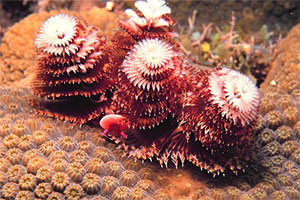
Food Habits
The reef butterflyfish is well suited to life on the reef. Its compressed body allows for darting in and out of coral. The small, protractile mouth is specifically adapted to crevice feeding. The teeth are long and slender, flattened, and slightly curved at the tips, designed for scraping and nipping at the small invertebrates, including polychaete worms, shrimps, and amphipods, that make up its diet. The reef butterflyfish can be quite acrobatic in its feeding, often swimming upside down to get into crevices where prey might be hiding.
Reproduction
Adult reef butterflyfishes often are found in pairs, suggesting monogamy and pair fidelity in the species. They spawn at dusk during a long, vigorous courtship. The pair circle each other, each fish head to tail until one fish breaks and darts off with the other close behind. The pair then swim upward and release the eggs and sperm. The female releases from three to four thousand eggs during the spawning event. The eggs are small, transparent and pelagic, and hatch within a day into minute, translucent silvery-grey larvae. The larvae of butterflyfishes are unique from all other species of fish. The head is encased in bony armor and large bony plates extend backwards from the head. These larvae, called “tholichthys,” grow to about 20mm, after which they settle on the bottom during the night. By dawn, they have already transformed into the juvenile stage of their life. Their color now closely matches the color of the adult. Those larvae that escape from predators and survive the transformation will hide in crevices until they are big enough to be relatively safe. The juveniles often inhabit shallow areas immediately adjacent to deeper water, like a channel or a ledge.
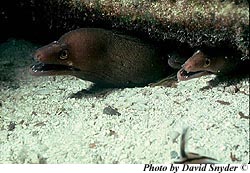
Predators
The reef butterflyfish has its share of predators. Larger reef fish like moray eels, snappers, and groupers, commonly consume this species. If threatened, the butterfly generally tries to swim away and hide, but if for some reason it can’t flee it often takes up a defensive posture. It turns and faces the aggressor with its head lowered and dorsal spines fully erected, similar to a bull about to charge.
Taxonomy
This species of butterflyfish was first described by Poey in 1858. Chaetodon gracilis Gunther 1860 and Sarothrodus sedentarius Poey 1868 also refer to this species. The name “Chaetodontidae” means “bristle-tooth” (“Chaeto” = bristle and “donte” = tooth), describing the teeth found in this family.
Prepared by: Casey Patton